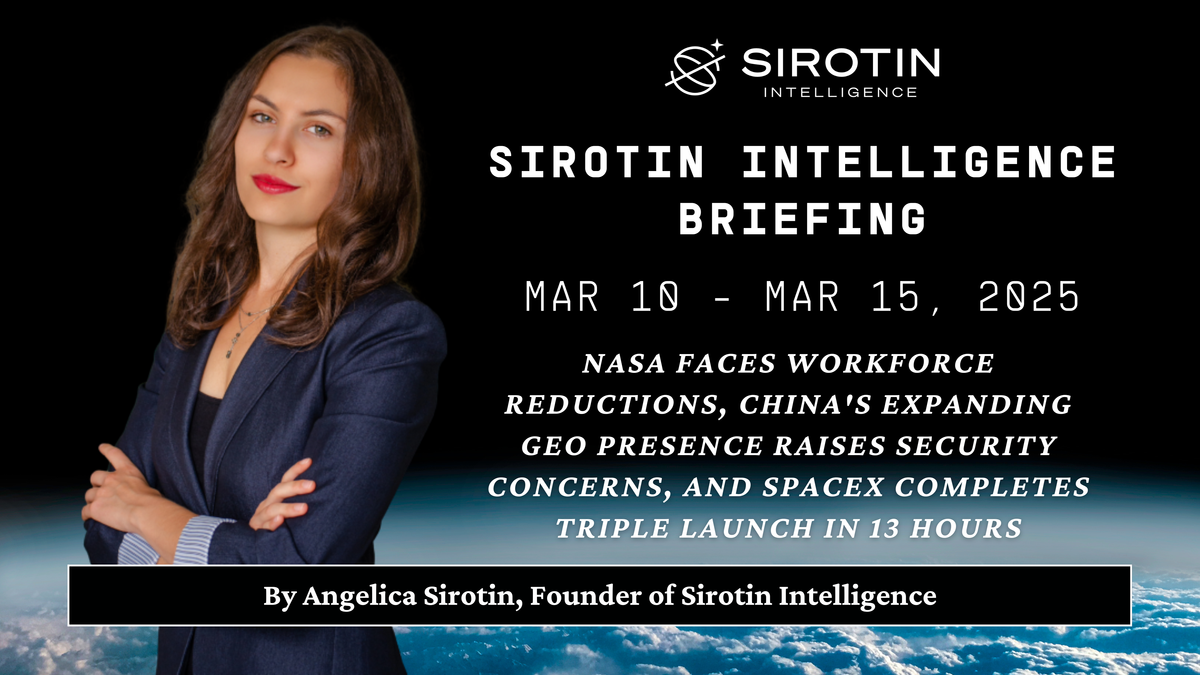Sirotin Intelligence Briefing: Mar 10 - Mar 15, 2025: NASA Faces Workforce Reductions, China's Expanding Geo Presence Raises Security Concerns, And Spacex Completes Triple Launch In 13 Hours
Nasa Faces Workforce Reductions, China's Expanding Geo Presence Raises Security Concerns, And Spacex Completes Triple Launch In 13 Hours

Welcome to this week's Sirotin Intelligence Briefing, your essential update on the final frontier. From March 10-15, we've tracked significant developments across defense, major contracts, policy shifts, and breakthrough technologies that are reshaping the industry landscape. Notable highlights include NASA's workforce reductions, SpaceX's impressive triple launch in just 13 hours, and the discovery of 128 new Saturn moons. Plus, don't miss our exclusive upcoming interviews with Space Force Association's Colonel Bill Woolf and Delta-V Analytics co-founder Niha Agarwalla, who are pioneering new approaches to space defense and satellite infrastructure management.
🛡️ Defense Highlights
- 🔄 NASA Headquarters Faces Reductions-in-Force: NASA has begun implementing RIFs at its Washington, D.C. headquarters in compliance with Trump Administration Executive Orders. Two offices (Office of Technology, Policy, and Strategy and Office of the Chief Scientist) and part of another (Diversity, Equity, Inclusion and Accessibility Branch) are being closed, affecting 23 employees.
- 🇨🇳 China's Expanding GEO Presence Raises Security Concerns: China has significantly increased its presence in geostationary orbit, raising security concerns among Western nations. The country's growing footprint in this strategically important orbital region has implications for space domain awareness and military capabilities.
- 💻 Space Systems Command Signs IT Contract with Trace Systems: Los Angeles Air Force Base and Space Systems Command have awarded Trace Systems a contract to provide Base Operations Support IT services. The company will deliver mission-critical IT services including NIPRNet and SIPRNet operations, incident response, and cybersecurity services to support U.S. Space Force operations.
- 📡 Rivada Targets U.S. Government Contracts: Rivada is preparing to deploy a 600-satellite network while actively pursuing U.S. government contracts. The company aims to provide secure communications capabilities that could serve defense and intelligence community needs.
- 🛰️ Intelsat Secures Border Security Customer: Intelsat has secured its first customer for a communications system designed for border security applications. The system leverages satellite technology to enhance surveillance and communications capabilities in remote border regions, demonstrating the growing intersection of commercial space capabilities with national security applications.
- 🌐 NATO Officials Observe U.S. Army Space Operations: NATO military officials gathered at Fort Carson on March 7 to observe U.S. Army space capabilities supporting multidomain combat operations. Col. Cobos emphasized that space operations are now essential to winning on land and critical for NATO's collective defense.
💼 Major Space Contracts
- 📝 Senate Introduces 2025 NASA Authorization Bill: A bipartisan group of Senators has introduced the NASA Transition Authorization Act of 2025, supporting American leadership in space, including NASA's Artemis program, leveraging private sector investment, and other ongoing priorities. The bill authorizes $25.478 billion for NASA in FY2025.
- 🏛️ House Passes Full-Year Continuing Resolution: The House narrowly passed legislation to keep the government funded through September 30, 2025, with a vote of 217-213. The bill would keep NASA funded at its FY2024 level of $24.875 billion, which is about $2 billion less than President Biden's request for FY2025.
- 🇬🇧 UK Achieves Record ESA Contract Wins: The UK space sector secured £80 million more in European Space Agency contracts than the government's contributions in Q4 2024, marking the most successful quarter for any ESA member state. Since June 2022, UK companies have secured £844 million in ESA contracts, expected to generate over £1 billion in wider economic benefits. The UK space sector generates £18.9 billion in annual income and supports 52,000 jobs.
- ☀️ Rocket Lab Selected for OneWeb Solar Panels: Airbus has awarded Rocket Lab a contract to provide high-efficiency space-grade solar panels for 100 OneWeb LEO satellites for Eutelsat Group. Rocket Lab will supply 200 solar panels manufactured at their Albuquerque facility, providing approximately 80 kW of power to the constellation.
- 🇳🇴 ISAR Aerospace Wins Norwegian Launch Contract: ISAR Aerospace has secured a contract from the Norwegian Space Agency for launch services, representing a significant win for the European launch provider as it works to establish itself in the competitive small satellite launch market.
- 🔗 Space Development Agency T2TL Gamma Solicitation: The SDA has issued a solicitation (SDA-PS-25-03) for the Gamma (γ) variant of the Tranche 2 Transport Layer (T2TL) to be executed by the Advanced Fire Control (AFC) Program. SDA expects to procure approximately 10 T2TL Gamma space vehicles with a payload specifically designed to close future kill chains via the PWSA. The solicitation involves both unclassified and classified materials, with responses due by April 22, 2025. This solicitation is part of a corrective action regarding information exchanged during a prior solicitation.
- 🌐 SDA BMC3 Multi-Mission Module Interface Documentation: SDA has issued a Request for Information (SDA-SN-25-0015) seeking industry feedback on in-space Battle Management, Command, Control and Communications (BMC3) Multi-Mission Module (M3) interface documentation. This RFI aims to assist in the development and refinement of interface documentation that will govern the interface between a future M3 and the SDA spacecraft it resides on. Responses are due by April 11, 2025.
- ✈️ Boeing Reaffirms Space Commitment: Boeing has reaffirmed its commitment to its space business, Space Mission Systems VP Michelle Parker confirmed at Satellite 2025. Despite an $11.8 billion loss in 2024 (including $500 million from Starliner), Boeing continues expanding with multiple contracts, including satellite programs for the Space Force and commercial customers, while subsidiaries Millennium Space and Spectrolab increase production capacity.
🌐 Policy, Geopolitical & Legal Developments
- 📡 New FCC Space Chief Seeks Licensing Reform: The Federal Communications Commission's new space bureau chief is pursuing licensing reform and more intensive use of spectrum. This initiative aims to streamline the regulatory process for satellite operators while ensuring efficient utilization of limited spectrum resources.
- 🔴 Trump on Mars Mission: President Trump stated that while sending humans to Mars would be "great," it is not at the top of his priority list despite endorsing the idea in two major speeches since returning to the White House. Trump noted that his mention of going to Mars received "one of the biggest applause of the night" during his address to Congress.
- 🇸🇬 Singapore's Space Strategy Creates Opportunity for Canada: Singapore unveiled its first-ever National Space Strategy on February 28, focusing on expanding the sector through innovation, fostering international partnerships, and developing targeted space programs. The strategy follows a C$162 million investment in the country's Space Technology Development Program launched in 2022.
- 🇪🇺 Europe Urged to Bolster Launch Capacity: A new report emphasizes that Europe must strengthen its space launch capabilities to reduce reliance on the United States. This call comes amid growing concerns about strategic autonomy in the space sector and the need for independent access to space.
- 🛰️ Multi-Orbit Operators Challenge Starlink Narrative: Several satellite operators with multi-orbit strategies are pushing back against the narrative of SpaceX's Starlink dominating the satellite communications market. These operators argue that diverse orbital approaches offer unique advantages and that the market remains competitive despite Starlink's rapid expansion.
- 🇯🇵 Japan Adjusts Space Development Approach: Japan is changing its traditional approach to space development to spur startup growth. Since launching its first satellite Ohsumi in 1970, Japan has relied on government agencies to drive space projects, but is now adjusting this strategy to help keep pace with the global space industry. The government remains a pivotal force in Japan's space sector while working to create opportunities for commercial entities.
🛰️ Technology & Commercial Developments
- 📱 Rocket Lab to Acquire Laser Communications Provider: Rocket Lab has entered into a non-binding term sheet to acquire a controlling equity position in Mynaric AG, a leading provider of laser optical communications terminals. The acquisition aims to address the "pain point" of laser communication for constellation operators by making optical terminals affordable and available at scale.
- 🇨🇳 China's Satellite Launch Milestone: China launched a cluster of 18 satellites from a new commercial spaceport on Hainan Island, marking a significant step for its commercial space sector. The launch used a state-developed Long March-8 Y6 rocket in a 'ride-share' mission for the first time, lifting satellites for the Spacesail (or Thousand Sails) project, which aims to compete with Elon Musk's Starlink.
- 👨🚀 SpaceX Crew-10 Launch Scrubbed: The launch of SpaceX's Crew-10 mission to the International Space Station was scrubbed less than an hour before liftoff due to a ground-side hydraulic issue with a clamp arm on the transporter erector. The international crew, including Commander Anne McClain (NASA), Pilot Nichole Ayers (NASA), and Mission Specialists Takuya Onishi (JAXA) and Kirill Peskov (Roscosmos), may attempt another launch on March 13 or 14, 2025.
- 🔭 Rocket Lab Expanding into Laser Communications: Rocket Lab is expanding its capabilities by acquiring Mynaric, a leading provider of laser communications technology. This strategic acquisition will enhance Rocket Lab's portfolio and position the company as a more comprehensive end-to-end space solutions provider.
- 🇬🇧 UK Space Sector Growth and Innovation: The UK space sector continues to demonstrate strong growth, supporting 52,000 jobs and generating an annual income of £18.9 billion. Recent contract wins are expected to create 3,800 highly skilled jobs, with the UK increasing its ESA geographical return rate from 93p per £1 invested in 2022 to 99p per £1 today.
- 📡 ESA Advances Future Data Transmission: The European Space Agency is laying foundations for the future of space-based data transmission through new initiatives and technologies. These efforts aim to enhance Europe's capabilities in handling the growing volume of data from space missions and Earth observation satellites.
- 🔧 Manufacturing Defect Identified in Vulcan Rocket: A manufacturing defect has been identified as the cause of an anomaly in the solid rocket motor of ULA's Vulcan launch vehicle. The discovery allows engineers to implement corrective measures to ensure the reliability of future launches of this new American rocket system.
- 💡 Frontgrade Qualifies Advanced Space Electronics: Frontgrade has successfully qualified the industry's first Class L Gallium Nitride (GaN) DC-DC converter and EMI filter for space applications. This technological advancement enables more efficient and reliable power management systems for satellites and other spacecraft.
- 🆘 Overwatch X Rescue Expands Satellite Safety Services: Overwatch X Rescue has expanded its lifesaving services to more satellite-enabled devices, enhancing emergency response capabilities for users in remote locations. The service leverages satellite technology to provide critical emergency communications when traditional networks are unavailable.
- 🍎 NASA Advances Space-Fermented Food Research: NASA's BioNutrients project is developing ways to use microorganisms to produce essential nutrients during long-duration space missions. The experiments use engineered yeast in a hand-held "production pack" system to manufacture fresh vitamins on-demand in space. BioNutrients-1 concluded in January 2024 after nearly five years, while BioNutrients-2 extended the study to almost six years. BioNutrients-3 completed analog testing in April 2024 and is scheduled to launch to the ISS later this year.
- 📻 Scientists Detect Mysterious Radio Signals: Researchers have traced regular radio pulses to a binary star system 1,600 light-years away in the constellation Ursa Major. The signals, which arrive every 125 minutes (2 hours), come from an extraordinary partnership between a white dwarf and red dwarf star. Their closely interacting magnetic fields create radio pulses that last between a few seconds to a minute. Dr. Iris de Ruiter first discovered these pulses in 2024 while examining archival data from the Netherlands' Low Frequency Array (LOFAR). The system has been named ILTJ1101.
- 🚀 SpaceX Completes Triple Launch in 13 Hours: SpaceX executed three launched in under 13 hours on March 14-15, 2025: Crew-10 to ISS, Transporter 13 rideshare with 74 payloads, and 23 Starlink satellites. The Starlink launch used booster B1078 for its 18th flight and was SpaceX's 31st Falcon 9 mission of 2025.
- 🪐 Astronomers Discover 128 New Saturn Moons: An international team using the Canada France Hawaii Telescope has confirmed 128 new moons orbiting Saturn. With this discovery, Saturn now significantly outpaces Jupiter's 95 known moons.
💭 A Word From Christophe Bosquillon
Intelligence Contributor, Senior Editor at Sirotin Intelligence
Jared Isaacman, upcoming NASA administrator, recently said: “There is a lot of taxpayer-funded science that should be reviewed & potentially reduced, but Planetary Defense against Near Earth Objects threats seems disproportionately underfunded relative to the likelihood and magnitude of the associated risks & consequences.” Beyond science in search of funding, we see Planetary Defense as a commercial opportunity. From an operational perspective, Planetary Defense (PD), asteroid mining (AM), and cislunar space situational awareness / space traffic management (Cislunar SSA/STM ) are deeply interconnected.
The tech and capabilities overlap presents commercial opportunities in resource utilization and orbital infrastructure protection. At this PD-AM-Cislunar SSA/STM intersection, opportunities in security and commercial development can be aligned with governments and private companies' interests.
Functionalities include landing and manipulation technologies, material characterization, remote operations and autonomy, kinetic/non-kinetic control, early detection and tracking, data sharing, coordination, defensive applications, orbital infrastructure protection, real-time resource mapping.
Cislunar SSA networks could detect and track both natural and artificial threats. Accurate asteroid maneuvering technologies could serve both PD and AM applications. Commercial services could execute such functionalities, serving the value chains of AM and space resource utilization, cislunar SSA/STM, and PD, along three directions:
+ AM and resource utilization: asteroid capture and redirection, mining extraction, in-situ processing
+ Cislunar SSA data services, subscription-based Cislunar STM, AI-driven threat analysis
+ PD services such as kinetic impact and deflection missions, gravity tractors, laser-based deflection
The dual-use nature of these services suggest government, including defense, as anchor customers, but also primes, and new-to-space industries majors, such as mining and construction companies. In addition, PD drills and readiness consulting in space as on Earth is a service opportunity.
Ultimately, space infrastructure could be commercialised to include space tug services, lunar and asteroid-based observatories, and in-orbit manufacturing and construction.It is time to move forward with a Private Space Security Company (PSSC) business model to include such features. That seems evident at first for security and servicing of mainstream orbital assets.
Then, based on the above, Planetary Defense could be modelled as a commercial-value driven and revenue generating activity, rather than yet another costly government program.
Have a great space week ahead!
🎤 Our Next Guests
Tuesday, March 18th, we feature an exclusive interview with Colonel Bill Woolf, Founder and President of the Space Force Association and 25-year space defense veteran who's bridging the gap between military space operations and public understanding.
🔍 Topics Covered:
- His journey from Star Wars-inspired child to missile launch officer to Space Force advocate
- The critical "awareness gap" in America's understanding of space-based infrastructure
- Why losing access to space would cripple everyday activities from gas pumps to credit cards
- How the Space Force Association is helping shape both policy and public perception
- His vision for protecting America's orbital assets against emerging threats from China and Russia
Don't miss this deep dive with a space defense expert who's working to ensure Americans understand the invisible infrastructure that powers modern life, while helping Space Force "Guardians" transition their expertise to the commercial sector and building the educational foundation for our orbital future.
Thursday, March 20th, we feature an exclusive interview with Niha Agarwalla, Co-Founder of Delta-V Analytics and pioneering data expert who's revolutionizing how we maintain and operate critical satellite infrastructure.
🔍 Topics Covered:
- Her journey from Microsoft and pharmaceutical data analytics to space tech entrepreneur
- How the $420 billion space industry is still operating with analog-era maintenance systems
- Delta-V's AI-driven digital twins that can predict satellite failures before they happen
- Why the next space revolution isn't about better rockets but smarter software
- Her vision for transforming mountains of satellite data into predictive intelligence
Don't miss this deep dive with a visionary who recognized what billionaire space entrepreneurs missed - that the key to sustainable space operations lies in bridging the gap between hardware innovation and software intelligence, potentially saving companies millions while making space infrastructure more resilient and reliable.
📚 Essential Intel from Our Archives
Missed a beat? These groundbreaking conversations are must-reads:
"Space Has a Scottish Accent"
Chris Newlands, CEO of Space Aye, discusses how his company's satellite technology is revolutionizing wildlife conservation and helping to combat illegal fishing and poaching.
"I Learned From the Last Generation of Manhattan Project Veterans”
Patrick McClure, former Kilopower Project Lead at Los Alamos National Laboratory, explains how small nuclear reactors could power future missions to the Moon, Mars, and beyond.
"We're Being Attacked Every Day"
Christopher Stone, Former Pentagon Space Advisor, warns about America's vulnerabilities in orbit and explains why China's "attack to deter" doctrine makes space conflict more likely than many realize.
"I Helped SpaceX Secure Their First Commercial Contracts"
Serial entrepreneur Robert Feierbach discusses building billion-dollar space ventures across four continents and developing North America's newest spaceport.
"We Can Fly 8,000 Miles In 2 Hours"
Jess Sponable, Ex-DARPA PM & President of NFA, explains how rocket-powered aircraft will revolutionize global travel through simplified hypersonic technology.
"This Could Be Our Biggest Economy"
Kevin O'Connell, Former Space Commerce Director, reveals how space is transforming from a government domain to a $1.8 trillion market.
"How Do You Win a War in Space?"
Ram Riojas, Ex-Nuclear Commander and Space Defense Expert, explains why the next war will start in space and how nations are preparing their defenses.
"First Day on the Job, Hubble Was Broken"
Mike Kaplan, James Webb Space Telescope Pioneer, reveals how early setbacks with Hubble shaped NASA's approach to complex space missions.
The Future of Human Space Habitation
Jules Ross reveals how her journey from artist to space visionary is reshaping human adaptation to space through Earth's first artificial gravity station.
Space Law's New Frontier
Attorney Michael J. Listner unpacks the complex legal challenges facing modern space activities. From resource rights to orbital debris management
Making Oceans Transparent From Space
Navy Legend Guy Thomas, inventor of S-AIS, shares how his invention transformed global maritime surveillance and security.





